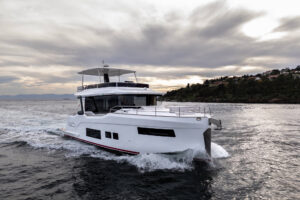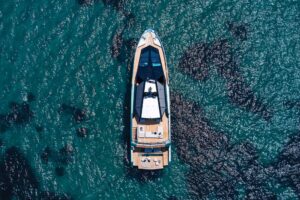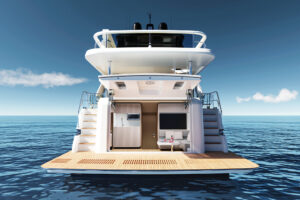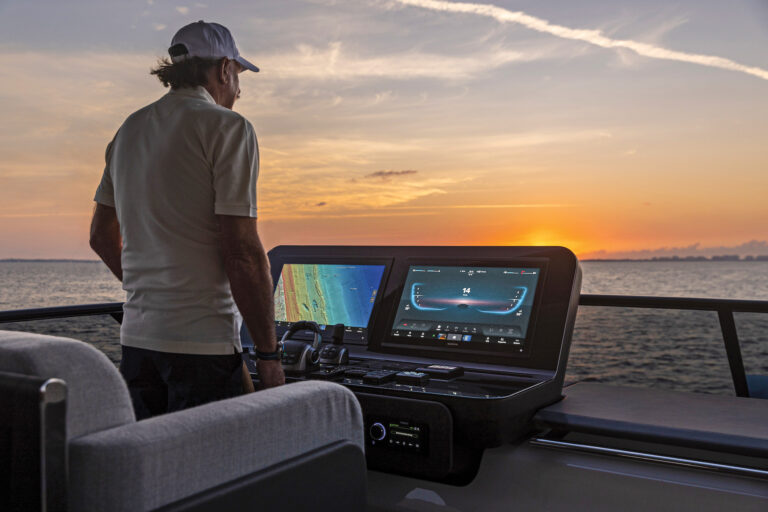Perhaps our Canadian brothers lack fine cuisine and elegant cars, but they certainly do not lack when it comes to boatbuilding. The strong U.S. dollar is one reason buying a Canadian-built boat is appealing, but it’s the country’s fine craftsmen and designers who make buying Canadian so smart. This point was driven home for me in St. Catharines, Ontario, where I tested the new Neptunus 56 Sedan Bridge.
When was the last time you sat around with your family and said, “Hey, let’s send out for some Canadian food?” When you bought that new car in the driveway, did you decide to really treat yourself and buy Canadian?
She is definitely one hell of a value, at $1,024,000 fully equipped. I heard the figure and asked for the price again, thinking the first response had been blurred by one too many Canadian beers (OK, they’ve got us beat on beer). You could pay several hundred thousand more for boats in this category, but the 56’s design and quality outshine that from other builders.
I’m at a loss for the proper terminology to describe her exterior styling, except to say that on some levels, it is quite appealing. I’ll admit I tend to gravitate toward more traditional styling, and the Neptunus is certainly a contemporary design. However, she is a little more stout and a little less frilly than other yachts in her class. She is a little more, shall we say, “yacht,” although Bermuda reds may still be inappropriate. As she raced toward us at flank speed, someone blurted out, “Now that is a good-looking boat.”
The 56 is fun to drive. She’s equipped with a pair of 800 hp Caterpillar 3406 diesels and cruises in the middle 20-knot range. She tops out at just over 30 knots with full tanks. Other Caterpillar and Detroit packages are optional, but she accelerated easily with the twin 800s and poked her nose out of the hole around 1650 rpm.
We sprinted onto a plane with no trim applied. Noise was minimal, registering only 78 decibels on the bridge and 75 in the master stateroom, which shares a bulkhead with the engineroom. She turned tight within a boat length and a half, and she kept the decks dry as we sliced through our own chop, a benefit of her deep-V.
The line of sight forward was clear, but it was slightly obstructed aft, especially with a tender installed on the overhang. I’m a big fan of placing the deck access directly behind the helmsman, to let him judge distance when backing into a slip.
The line of sight is very good from the lower station, a great option during long trips. It’s always a pleasure to arrive in air-conditioned comfort, absent salt scales on your skin. The 56’s lower helm has ample room for electronics, including the longer plotters that are popular today. I would suggest adding a foot recess of some sort, so taller captains can stretch and sit at a more natural incline.
Engineroom access is from the cockpit, and the space is well laid out. Mechanics expecting the cramped, knuckle-scraping holes found on similar-size boats will breathe a sigh of relief. Outboard access is good, and routine maintenance is well addressed. Wiring is properly labeled, and runs are neat, almost artlike.
The interior reflects the company’s willingness to work with each owner’s taste. “We’re a semi-custom builder,” said Ray Thompson, marketing manager for Neptunus. “They choose their own wood, fabrics, carpet.”
Our test boat’s owner was a perfect example, someone who had owned a Neptunus and traded up the line. Thompson knew how this owner had used his previous yacht, and the main saloon on the 56 was designed to accommodate his healthy entertainment schedule. A bar is opposite a plush circular settee, with two levels of side windows providing good views for a party atmosphere.
The galley is a refreshing change of pace. Its U shape surrounds the cook, makes preparation easy and keeps things safe. The galley’s location, between the forward settee and main saloon, is an added bonus. Appliances and hardware are top shelf. Our test boat had a double sink, a dishwasher, a three-burner ceramic-top Princess stove, a Panasonic microwave/convection oven and a Sub-Zero refrigerator and freezer. Despite all the appliances, stowage was plentiful, including overhead cabinets, a pantry and enough space to bring the daily dishware and the good china.
Headroom decreases forward, in the dinette. At first I thought this was a nuisance, but later decided it works just fine. Anyone in the dinette or helm station areas is likely to be sitting, so 6-feet-plus of headroom is an unnecessary design element that would compromise the yacht’s exterior profile.
A stack washer and dryer is at the foot of the steps to the lower deck. It’s nice to see a real stack unit for a change. Having used the combo units a number of times, I’ve concluded I would be better off blow-drying my shorts.
Forward, the passageway’s headroom seems cathedral-like. The master stateroom is amidships, a guest stateroom with twin berths is to starboard, and a VIP is forward. Again, stowage is abundant and the builder’s touches are nice. Innerspring mattresses, entertainment centers and marble heads define a high level of luxury.
The slightly narrow side decks pay the price for all the interior volume, so I would add grab rails above the side windows to aid in walking forward. Nonslip would also be a good idea on the forward portion of the raised cabin. Hardware is stout and functional and includes large cleats, a low-profile Lewmar windlass and a deep anchor locker. A sunpad is also forward.
Thompson expects to build about 15 boats this year at the Canadian factory and another 70 or so at the company’s Holland affiliate.
Contact: Neptunus, (905) 937-3737; fax (905) 937-9144; www.neptunusyachts.com.









